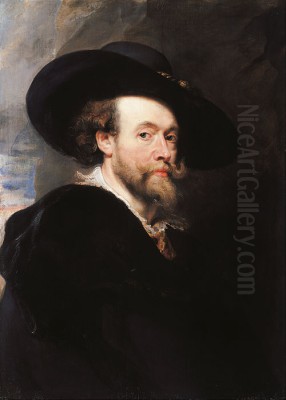
Peter Paul Rubens stands as a colossus in the annals of art history, the embodiment of the Flemish Baroque style. Born during a time of religious and political turmoil, he rose to become not only the most sought-after painter in Northern Europe but also a respected diplomat, scholar, and collector. His life (1577-1640) spanned a period of immense change, and his art, characterized by its dynamism, vibrant color, and sensual energy, captured the spirit of the age. More than just an artist, Rubens was a true Renaissance man in the Baroque era, navigating the complex worlds of art, patronage, and international politics with remarkable skill and success.
Early Life and Formative Years in Italy
Peter Paul Rubens was born on June 28, 1577, in Siegen, Westphalia (modern-day Germany). His father, Jan Rubens, was a Calvinist lawyer and alderman from Antwerp who had fled the Spanish-controlled Southern Netherlands due to religious persecution under the Duke of Alba. Following Jan Rubens's death in 1587, his widow, Maria Pypelinckx, returned to Antwerp with her children, where Peter Paul was raised Catholic and received a classical education, studying Latin and Greek literature. This humanist grounding would profoundly inform his later work.
His artistic training began in Antwerp, likely first with Tobias Verhaecht, a landscape painter, followed by apprenticeships with more significant history painters Adam van Noort and, crucially, Otto van Veen. Van Veen, a court painter to the Archdukes Albert and Isabella, rulers of the Spanish Netherlands, instilled in Rubens a respect for classical ideals and Italian Renaissance art. In 1598, Rubens became an independent master in the Antwerp Guild of Saint Luke.
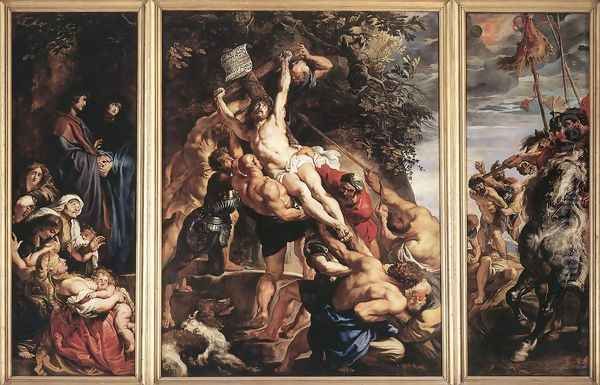
Seeking to immerse himself in the art he admired, Rubens traveled to Italy in 1600. This eight-year sojourn was transformative. He initially entered the service of Vincenzo Gonzaga, Duke of Mantua, which provided him opportunities to travel to Venice, Rome, and Genoa. In Venice, he absorbed the rich colors and dramatic compositions of Titian, Veronese, and Tintoretto. In Rome, he studied classical sculpture and the High Renaissance masterpieces of Michelangelo and Raphael, as well as the revolutionary naturalism and dramatic lighting (chiaroscuro) of his contemporary, Caravaggio. These diverse influences coalesced into a powerful, personal style.
Return to Antwerp: Fame and the Workshop
Rubens returned to Antwerp in 1608, initially drawn back by news of his mother's illness, though she passed away before he arrived. The city was enjoying renewed prosperity under the stable rule of Archdukes Albert and Isabella, fostering a climate ripe for artistic patronage. In 1609, Rubens was appointed court painter to the Archdukes, granted special privileges that allowed him to remain based in Antwerp rather than relocating to their court in Brussels, and permitted him to work for other clients.
That same year, 1609, marked another significant event: his marriage to Isabella Brant, the daughter of Jan Brant, a prominent Antwerp city clerk and humanist. This union connected Rubens firmly to the city's elite. His famous double portrait with Isabella Brant exudes confidence and affection, showcasing his burgeoning status. This period saw the creation of some of his most celebrated altarpieces for Antwerp churches, including the monumental Raising of the Cross (1610-11) and Descent from the Cross (1612-14) for the Cathedral of Our Lady, works that cemented his reputation with their dramatic intensity and masterful execution.
To meet the overwhelming demand for his work, Rubens established a large, highly organized workshop, arguably the most efficient artistic enterprise in Europe at the time. He employed numerous assistants and specialists, distinguishing between pupils learning the craft and skilled collaborators who executed specific parts of paintings under his direction. Masters like Anthony van Dyck (his most famous pupil), Frans Snyders (renowned for animals), and Jan Brueghel the Elder (known for flowers and landscapes) frequently collaborated with Rubens, contributing their expertise to large-scale commissions. Rubens often provided initial sketches or oil studies, oversaw the execution, and added the final, unifying touches himself.
The Quintessential Baroque Style
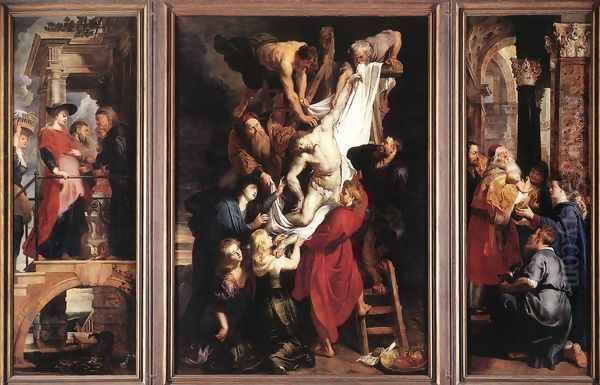
Rubens's art is synonymous with the Baroque. His style is characterized by exuberant movement, rich, sensuous color, dramatic contrasts of light and shadow, and an energetic dynamism that seems to burst from the canvas. He masterfully blended the realism and detailed surface textures typical of Flemish tradition with the idealized forms, classical learning, and monumental scale he had absorbed in Italy. His compositions are often complex, featuring swirling diagonals, foreshortened figures, and a palpable sense of energy and emotion.
He excelled in depicting human flesh, particularly the female nude, rendering it with a vitality and warmth that was both idealized and tangibly real. His figures, often muscular and full-bodied, convey intense emotions, whether in scenes of religious ecstasy, mythological drama, or violent hunts. This emphasis on movement, emotion, and the senses aligned perfectly with the aims of the Counter-Reformation Catholic Church, which sought art that would inspire piety and awe in the faithful. Rubens became one of its most powerful visual proponents.
His technical brilliance was matched by his intellectual depth. Steeped in classical literature and history, he imbued his mythological and allegorical works with complex layers of meaning, accessible to the educated patrons of the era. He painted with remarkable facility, using fluid brushwork and often allowing the underpainting or sketch lines to remain visible, contributing to the sense of immediacy and vigor in his work.
Masterpieces Across Genres: Religion and Mythology
Rubens's vast output spanned numerous genres. Religious paintings formed a cornerstone of his work, particularly large altarpieces commissioned by churches and religious orders across Catholic Europe. Works like The Descent from the Cross are celebrated for their emotional power and theological depth. The Assumption of the Virgin (various versions) captures the celestial drama with swirling figures and divine light. The Ildefonso Altarpiece, a triptych commissioned for the church of Saint James on the Coudenberg in Brussels, showcases his ability to integrate portraiture (of the Archdukes) within a sacred narrative.
His designs for the Triumph of the Eucharist tapestry series, commissioned by the Infanta Isabella Clara Eugenia for the Convent of Las Descalzas Reales in Madrid, represent one of the grandest artistic projects of the Baroque era. These complex allegorical scenes, celebrating Catholic doctrine, demonstrate his inventive genius and ability to manage vast, multi-faceted commissions.
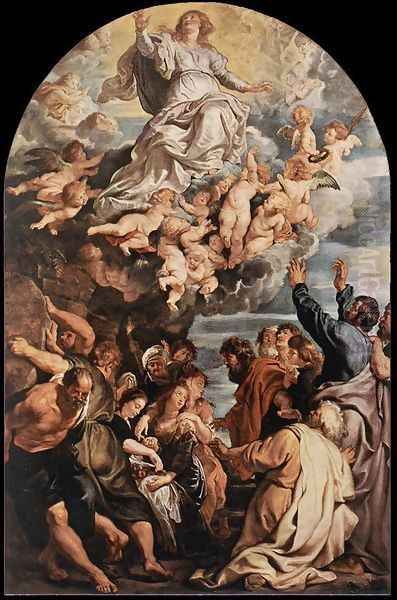
Mythological and historical subjects provided fertile ground for Rubens's dynamic style and classical knowledge. The Rape of the Daughters of Leucippus depicts the abduction of Phoebe and Hilaeira by Castor and Pollux with a whirlwind of energy and sensuousness. The Battle of the Amazons is a tumultuous scene of combat, showcasing his mastery of complex, multi-figure compositions. His mythological works often explore themes of love, conflict, and transformation, rendered with unparalleled vitality.
Historical Cycles and Portraiture
Among Rubens's most ambitious projects were large narrative cycles. The Life of Marie de' Medici, commissioned in 1621 by the French Queen Mother for the Luxembourg Palace in Paris, comprises 24 monumental canvases depicting (and often glorifying) events from her life. This cycle blends portraiture, history, and allegory on an epic scale, navigating delicate political issues through masterful visual storytelling. It remains a landmark achievement of Baroque courtly art, now housed in the Louvre.
Another significant cycle depicts the life of the Roman consul Decius Mus, commissioned by Genoese patrons. This series allowed Rubens to explore themes of civic virtue and sacrifice drawn from Roman history, demonstrating his versatility and engagement with classical sources. Later in his career, The Consequences of War (1638-39), painted for Ferdinando II de' Medici, Grand Duke of Tuscany, serves as a powerful allegorical statement on the horrors of the Thirty Years' War.
While perhaps less famous for portraits than his pupil Van Dyck, Rubens was a superb portraitist. His depictions of his family, particularly his wives Isabella Brant and Helena Fourment, are imbued with warmth and intimacy. His Self-Portraits project an image of confidence, intelligence, and worldly success. He also painted numerous portraits of rulers and aristocrats across Europe, including Philip IV of Spain and Charles I of England, often combining likeness with symbols of power and status. Albert and Nicolaas Rubens, a tender portrait of his sons, reveals a more personal side.
Landscapes and Later Life
In his later years, particularly after acquiring the Château de Steen near Antwerp in 1635, Rubens turned increasingly to landscape painting. These works, often depicting the Flemish countryside around his estate, are characterized by their atmospheric depth, vibrant light, and panoramic scope. An Autumn Landscape with a View of Het Steen in the Early Morning is a prime example, celebrating the beauty and fertility of the land. These landscapes were highly influential on subsequent generations of artists.
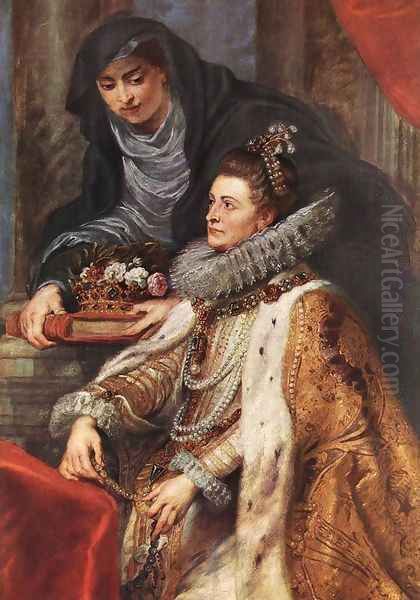
His personal life saw both sorrow and joy. The death of his beloved first wife, Isabella Brant, from the plague in 1626 was a heavy blow. Four years later, in 1630, the 53-year-old Rubens married the 16-year-old Helena Fourment, the beautiful daughter of a silk merchant. She became his muse, frequently appearing in his later works, both in portraits like Helena Fourment in a Fur Wrap (Het Pelsken) and as a model for mythological or religious figures, such as in The Three Graces or The Garden of Love. This latter work, likely a personal painting celebrating his own happiness, depicts an idyllic gathering in an elegant garden.
Rubens continued to paint prolifically, though increasingly troubled by gout. His later works sometimes show a looser brushwork and a greater emphasis on light and atmosphere. He remained active until the end, a testament to his discipline and passion for his art.
Diplomat and Knight
Beyond his artistic achievements, Rubens played a significant role in European diplomacy. His intelligence, charm, classical education, and fluency in multiple languages made him an ideal envoy. He undertook sensitive diplomatic missions for the Archdukes Albert and Isabella, and later for the Infanta Isabella after Albert's death, primarily aimed at negotiating peace between the Spanish Netherlands, the Dutch Republic, Spain, and England during the tumultuous period of the Thirty Years' War.
His status as a renowned artist gave him access to the highest circles of power. Between 1628 and 1630, he traveled extensively, engaging in peace negotiations at the Spanish court in Madrid and the English court in London. His efforts contributed significantly to the treaty signed between Spain and England in 1630. In recognition of his diplomatic services, he was knighted by Philip IV of Spain in 1624 and by Charles I of England in 1630. This dual role as artist and diplomat was unique and highlights his extraordinary talents and the high esteem in which he was held.
Collector and Legacy
Rubens was also an avid collector of art and antiquities. His house in Antwerp, designed by himself in the Italian palazzo style, contained a vast collection of paintings (including works by Titian and Tintoretto), Roman sculptures, gems, coins, and drawings. This collection served not only as a source of inspiration but also as a mark of his status and erudition. He sold a significant part of his collection to the English Duke of Buckingham in 1627.
Peter Paul Rubens died in Antwerp on May 30, 1640, likely from heart failure brought on by chronic gout. He was buried in the St. James' Church (Sint-Jacobskerk) in Antwerp, in a chapel for which he had painted an altarpiece.
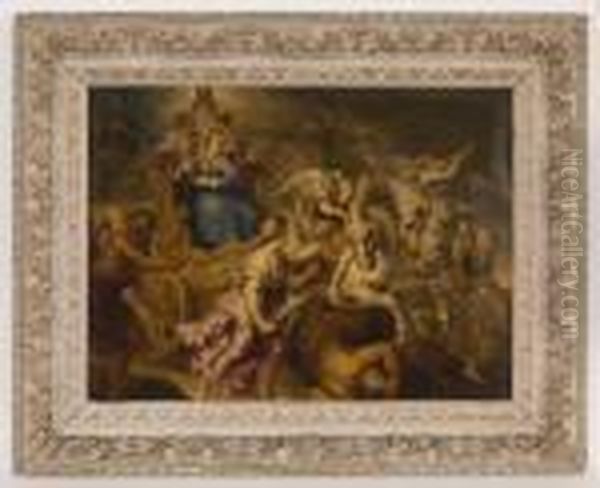
His legacy is immense. As the leading master of the Northern Baroque, he synthesized Italian Renaissance grandeur with Flemish realism, creating a vibrant, dynamic style that dominated European painting for decades. His workshop model influenced artistic production, and his pupils and collaborators, especially Anthony van Dyck and Jacob Jordaens, carried his influence forward. Later artists, from Watteau and Fragonard in the Rococo period to Eugène Delacroix in the Romantic era and even Impressionists like Renoir, looked to Rubens for his mastery of color, composition, and expressive brushwork. He remains a towering figure, celebrated for his artistic genius, his intellectual depth, and his remarkable life bridging the worlds of art and power.